Why currant leaves curl and what to do with it
Often, gardeners are faced with a problem when, during the fruiting period, currant leaves curl, quickly lose color, dry out and fall off. This means that crop losses are inevitable. To save the bush, it is important to find out who is to blame - pests or diseases. In this article, we will consider why the leaves curl and what to do about it.
The content of the article
Why currant leaves curl
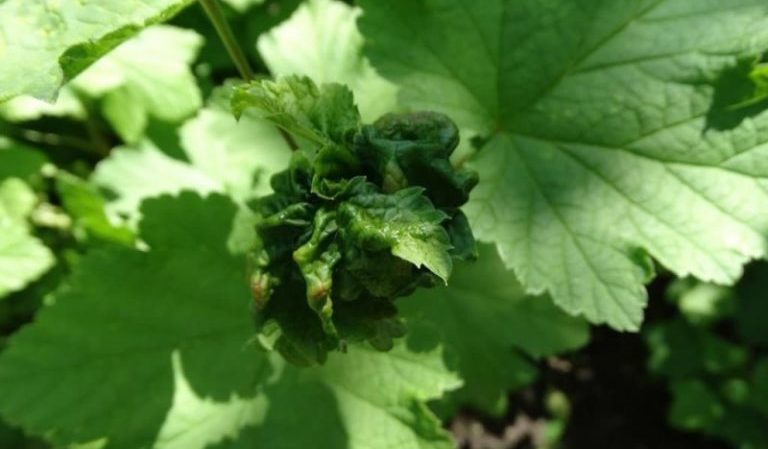
The currant is susceptible to pathogens and insects. The risk of injury depends on the type of plant. So, black currant suffers from pests much less than red. Specific pests are leaf rollers, aphids, spider mites, and glass.
The damaged plant lags behind in growth, withers, ceases to bear fruit, and then dies prematurely. If currant leaves curl, you need to unfold them and carefully examine for the presence of larvae, cobwebs, growths and spots.
Leaf roll
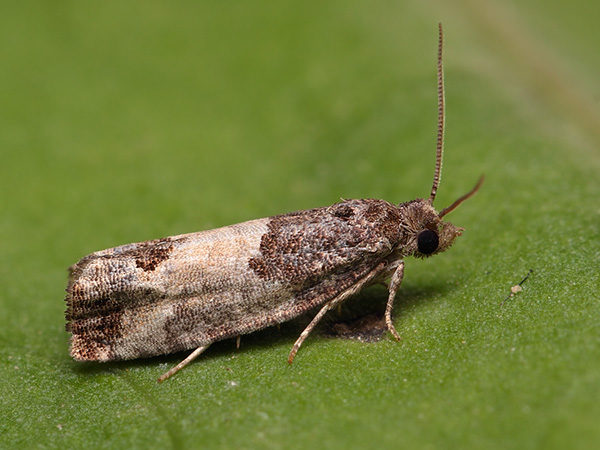
Currants are often attacked by a curved leafworm - a medium-sized butterfly 10-20 mm long. Sexually mature individuals are light green or green in color.... The front wings are buffy or brown in color, the hind wings are dark gray with a yellow margin.
Insects feed on all parts of the plant, but most often infect the leaves. A characteristic feature is a cobweb, a viscous secret secreted by leaf rollers for better fastening during the period of rolling the leaves around them.
For reference. The rolled leaves must be torn off and burned. Do not leave them in the compost heap or the plant's trunk circle. Otherwise, the larvae will overwinter safely, and in the spring the invasion of the leafworm will repeat.
Means to fight
Gardeners distinguish 3 methods of exposure to an insect:
- Traditional methods. Garlic infusion: 1 clove of minced garlic for 1 liter of boiled water. Insist concentrate for 5-7 days. Before irrigation, dilute in water in proportions of 60 ml per 10 liters of water.
- Bioinsectoacaricides. These drugs are safe for humans, not phytotoxic.
- Insecticides. The greatest efficiency and quickest results are achieved using chemicals. They are toxic, so they resort to their help in extreme cases, when the affected area is large, and biological products and folk methods are ineffective.
Bioinsectoacaricides
Most popular:
- "Aktofit". Kills pests 3-8 days after treatment. Dissolve 2 ml in 1 liter of water. Pour the required rate into 0.5 liters of water, stirring constantly. Pour the resulting solution into the sprayer tank 1/3 full. Close, shake 2-3 times and proceed to processing.
- "Lepidocide". The action of the drug is aimed at destroying caterpillars. The death of pests is observed for 2-3 days. The plant is treated during the growing season at least 2 times at intervals of a week. The dosage is 20-30 ml per 10 liters of water. The average consumption of the solution is 2-5 liters per adult bush.
Insecticides
Examples of drugs:
- "Kinmix". They are used against larvae and adults no more than 2 times per season, since the agent causes resistance. In case of an overdose, the plant inhibits, therefore, the instructions should be strictly followed. For 1 bush, 1-1.5 liters of solution is enough. For its preparation, 2.5 ml of the product is diluted in 1.2 liters of water. While stirring, add more water to a total volume of 10 liters. The last processing is carried out no later than 14 days before harvest. Can be alternated with other insecticides.
- "Karbofos". It is used when the buds open and during the budding period. Dilution proportions - 75 g per 10 liters. This volume is enough for 6-7 plants. On average, 1 adult bush takes 1.5 liters of solution. They also cultivate the soil and grass around.
Aphid
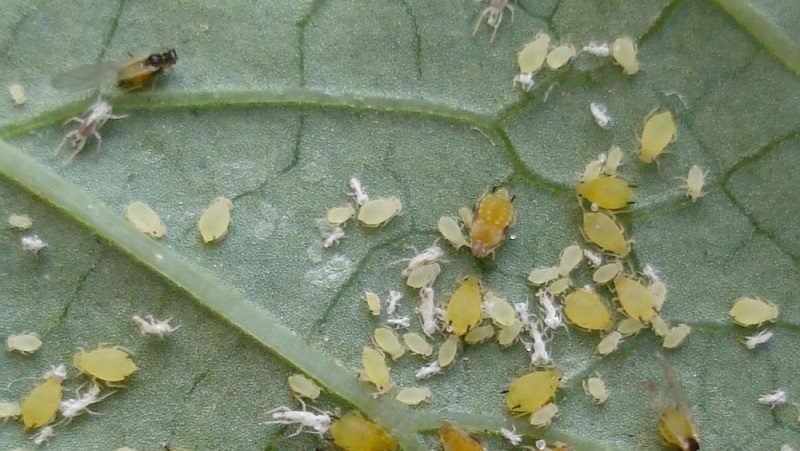
Often, currants are attacked by gallic (redcurrant) aphids. These are small, almost transparent insects of a pale green-yellow hue, without wings. The presence of a pest can be easily identified by the appearance of brown and yellow swellings on the top of the leaf. Gradually, the tubercles begin to darken, and the leaves of the currant curl. How to treat the plant depends on the development cycle of the insect. For sexually mature individuals, the use of insecticides is optimal. If you have to get rid of the clutch of eggs, it is better to use folk methods.
Aphids spoil currant leaves until mid-July, after which they move to other plants. Eggs are laid in autumn. They winter safely on the branches, the larvae appear in early spring.
For reference. Gallic aphids rarely settle on black currants, preferring colored varieties. They have thinner leaves, it is easier for an insect to pierce them and extract sap.
Folk remedies
The following methods are popular among gardeners:
- Irrigation of bushes with boiling water. Ideal for dealing with egg clutches. After boiling, the water is poured into a watering can with a diffuser and the plants are abundantly irrigated. After a hot shower, it is recommended to treat the trunks with lime, which also contributes to the destruction of eggs.
- Baking soda solution. The plant is treated in early spring, when the buds have not yet blossomed. 40 g of grated laundry soap is diluted in 10 liters of water, sodium bicarbonate is introduced at the rate of 2 tbsp. l. for 1 liter.
- Soap solution. In its pure form, it is effective if the aphid has just appeared on the plant. Rub 1.5 pieces of laundry soap, completely dissolve in 2 liters of warm water. Then add another 8 liters of water. Strain before use in a nebulizer.
- A decoction of celandine. 4 kg of crushed plants are poured into 10 liters of water and infused for 4-5 hours. The liquid will turn dark brown. Strain and start processing shrubs.
Biological preparations
They are safe for humans, do not harm the plant. They are actively used during the fruiting period. You can use "Aktofit" (as when fighting a leaf roll) or give preference to "Fitoverm".
The death of pests occurs 2-3 days after the primary treatment of the plant. The consumption of the drug is 2 ml per 1 liter of water. Fitoverm is used as pests appear during the growing season. 2-3 treatments are enough with a time interval of 5-7 days.
Chemicals
Toxic, not used during fruiting. After rains, re-treatment is necessary. The use of insecticides is justified when insects attack in large quantities and when other methods are ineffective.
Important! Harvesting begins no earlier than 20-30 days after the last insecticide treatment.
Most in demand:
- Actellik. A product with a high rate of destruction and suppression of pests. The dosage is 1.5-2 ml per 1 liter of water. 2 treatments are enough with an interval of 5-7 days. Well compatible with biological products.
- Biotlin. The complete death of pests occurs 3-4 hours after treatment. The dosage is 3 ml per 10 liters of water. The consumption rate depends on the size of the bush - from 0.5 to 1.5 liters.
Spider mite
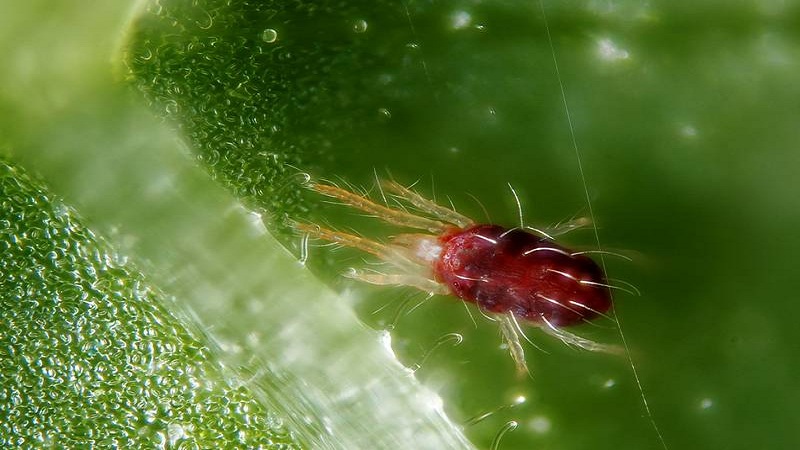
The appearance of a tick can be recognized by a thin gray spider web, yellowing and twisting of leaf plates, weakening of the growth of bushes. Due to the small size of the pest, it is very difficult to spot in time. Infection usually starts from the lower leaves, gradually spreading to the upper young ones. It is recommended to carefully examine the oldest leaves for spotting. Larvae and adult mites are localized on their lower part.
Timely detection of ticks is the key to the effectiveness of treatment. Active period breeding falls in the second half of spring.
Folk remedies
It is better to irrigate the bushes with infusions with a deterrent smell:
- Garlic. 5 cloves of chopped garlic pour 1 liter of cold water. Insist 10-12 hours until air bubbles appear. Strain, dilute with water in a 1: 1 ratio, spray on the bushes. Repeat treatment in 2-3 weeks.
- Tobacco. Pour 2.5 liters of hot water over 250 g of dry leaves, dust or crumbs. Insist during the day. Strain, add another 0.5 liters of water. For better adhesion of the product to the leaves, you can add 20 g of grated laundry soap.
- Herbal. Wormwood, celandine, calendula will do. For 10 liters of hot water - 100-120 g of herbal raw materials. Insist 2-3 hours. Strain before irrigation.
Colloidal sulfur can also be used to suppress the vital activity of ticks and prevent their spread.
Biologicals
What to do if leaves curl due to tick activity:
- Use "Fitoseyulus"... It contains live predatory mites that eat spider webs. With a rapidly growing population of 1 m², 20-50 predatory mites are evicted every 14 days. After the destruction of the spider webs, the bio-predator also dies.
- Apply "Bitoxibacillin". Most effective at the larval stage of pests. The powder consumption rate is 80-100 per 10 liters of water. The last treatment is carried out 5 days before harvest.
Acaricides and insectoacaricides
A spider mite is not an insect, it belongs to the class of arachnids, so it is irrational to use insecticides. Ticks are adversely affected by acaricides and insectoacaricides. Usually, 2 treatments per season are sufficient, excluding the flowering time of the currant.
Important! For safety, chemical treatment is best done in dry and calm weather, using personal protective equipment.
Most often used:
- "STOP tick". Does not affect plant growth and development. Kills pests in the first minutes of treatment. The drug acts at all stages of insect development, has a long period of protective action. Consumption rate - 7 ml for 5-6 liters of water.
- "Envidor"... Effective at all stages of pest development. It is used on fruit and berry bushes twice a season, no later than 20 days before harvest. Can be used in rainy weather. The consumption rate is 2-3 ml per 5 liters of water.
- Sunmight. It is effective against not only ticks, but also other insects. Best used during active flowering. Possesses good absorbency, therefore does not require re-processing after precipitation. One procedure per season is enough. The consumption rate is 5 g per 5 liters of water.
Glass-maker
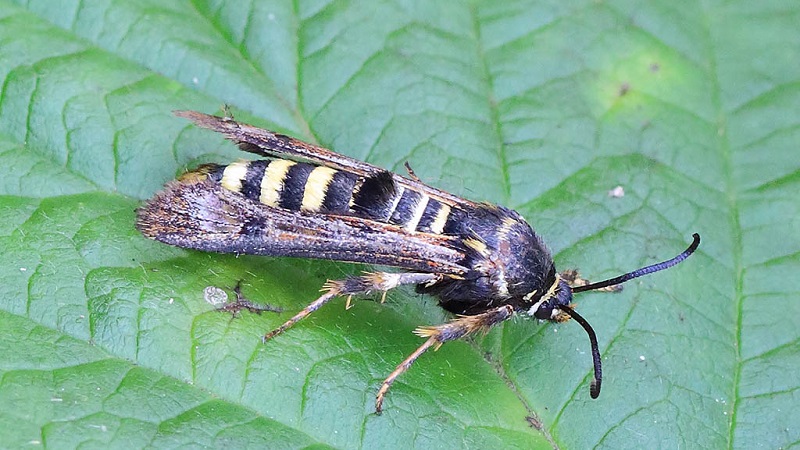
These are caterpillars with a whitish body and a black head. The pest prefers young black currant bushes. Caterpillars appear at the end of June. They move along the entire shoot down to the root, gnawing out the core and leaving a hollow place. With a longitudinal section of the branch, the course with the caterpillar or its excrement is clearly visible. Damaged shoots stop growing, dry up and break off. The bush does not bear fruit well, the berries become sour.
How to destroy
The caterpillar hibernates in the branches, therefore, if a pest is found, dry shoots must be cut and eliminated. The procedure is carried out throughout the growing season.
Traditional methods are aimed at scaring off adults. For this, homemade traps are used. In the form of bait, cardboard of red or yellow color is installed, under which cans of molasses are placed. The bright color attracts butterflies, but they cannot cling to the cardboard and fall into the sticky jar. To scare away, small rags soaked in gasoline are hung on the bushes. The pungent smell interrupts the aroma of currants and prevents butterflies from detecting it.
For reference. They begin to process currants as soon as at least one of the adults falls into the trap.
Biological insecticides, for example, "Bitoxibacillin", can be used only at the stage of prophylaxis.
Chemicals

Only chemicals help in pest control:
- "Karbofos". You can use a 10% solution of the drug.The first treatment is carried out in early spring (before the buds open), the second - after flowering. Consumption rate - 30 g per 4 liters of water. One bush is enough for 1-2 liters.
- Inta-Vir". Used before flowering currants. 1 tablet is enough for 10 liters of warm water. It is ground and diluted in 300 g of water, then another 700 g is added and stirred. The mother liquor is ready. After that, the water is added to the norm, shaken and irrigated.
If the complex measures turned out to be ineffective, the damaged bush is cut at the root and burned.
Pest prevention
Preventive procedures are carried out in the fall, so that the pests have no chance to lay eggs:
- Additionally, they are treated with insecticides if the bush has been affected by pests. Also, the procedure is carried out in the spring, before bud break.
- Make sanitary and regulatory pruning... Weak, diseased, withered and thickening branches are removed. Places of cuts are treated with garden pitch.
- After falling leaves abundantly watered the crown, the trunk circle are carefully loosened so as not to touch the surface roots. It can be sprinkled with wood ash, mustard or ground pepper.
- Collect and burn the yellowed leaves.
- Plants with a pronounced aroma (garlic, onion, calendula, etc.) are planted near the currant.
To exclude the penetration of larvae into the bark of the plant, all care work is carried out as carefully as possible, without damaging the bark.
Conclusion
If currant leaves curl, it is important to understand what kind of pest attacks and how to treat it, because the safety of the crop is at stake. For some pests, folk remedies are enough; in the fight against others, you will have to use several types of insecticides per season.